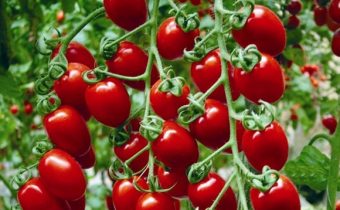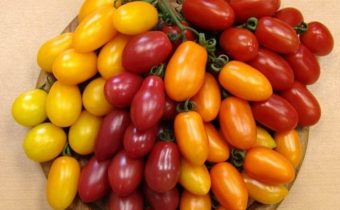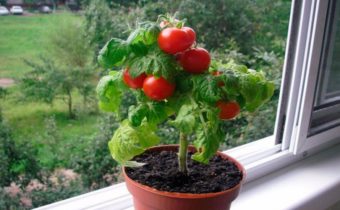Tomato "Sweet cherry f1": unusual, original and specific

One of the defining characteristics of a tomato is its size. Most amateur vegetable growers prefer to have on their plot two main types of tomatoes - large, fleshy for fresh consumption, salad and medium-sized, for canning.
The appeared small-fruited varieties of tomatoes do not seem to fall into any of these categories, however, they attracted attention because of the original appearance and specific taste.
Long clusters of miniature cherry tomatoes attract customers with their beauty, and when you try them, and a very pleasant taste. Sweet Cherry variety tomatoes are one of a large family of small-fruited tomatoes, which was called the “Candy Tree” for its unusual appearance and popularity among kids.
general information
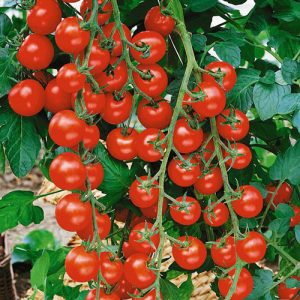 This hybrid, from the whole range of small-fruited tomatoes, is most interesting as unpretentious and very fruitful. The plant is indeterminate, resistant to temperature extremes and most fungal diseases, belongs to the ultra-early varieties. The term of maturation is 75-80 days after sowing.
This hybrid, from the whole range of small-fruited tomatoes, is most interesting as unpretentious and very fruitful. The plant is indeterminate, resistant to temperature extremes and most fungal diseases, belongs to the ultra-early varieties. The term of maturation is 75-80 days after sowing.
Thanks to these qualities, Sweet Cherry's tomato began to attract the attention of many summer residents, for whom the characteristics and description of the variety would be interesting.
Variety description
Tomatoes of this variety can be grown in different conditions: in greenhouses, open ground, and some lovers plant them in pots on the balconies. Since the plant is indeterminate, that is, without limiting the growth point, when creating a comfortable environment, it grows up to 2 meters or more in greenhouses.
Bushes are powerful, during the fruiting period have a very attractive appearance. Forming plants and the garter to the trellis is obligatory, as the stem during the fruiting period may break. The long clusters of tomatoes Sweet Cherry F1, according to gardeners, are simply dotted with clusters of small, photo-like cherry berries, fruits.
Fruits have an unusual appearance for tomatoes:

- Small round fruits are similar to berries and weigh from 10 to 20g and are collected in large brushes with 30-50 pieces each.
- The shape of the tomatoes is round, smooth.
- Fruits do not crack.
- The flesh is quite dense, the color of ripe fruit is bright, red.
- They hang on the branches for a long time, they do not crumble, they usually harvest crops with tassels, sometimes without waiting for the maturity of all the fruits of the hand.
Pleasant sweetish taste, and tomatoes contain up to 12% of sugar and dry substances, making them a favorite treat for children and adults. Housewives use it not only for fresh food, as a delicacy, but also as a decoration of various dishes.
All this makes the hybrid attractive for summer residents, especially since the tomato Sweet Cherry, according to their reviews and plant photos, also gives a good yield - up to 8 kg from a bush.
See also: The best hybrids of tomatoes with photos and descriptions
Pros and cons varieties
When growing tomatoes in the greenhouse, gardeners usually achieve higher yields and fruit quality, with more clearly manifested the advantages of the variety:

- The term of fruit ripening is not only early, but also extended.
- Resistance to temperature changes, which allows to receive fruits during periods of cooling.
- Resistant to most fungal diseases.
- Excellent taste and appearance of the fruit.
- An attractive type of plants themselves - powerful and tall.
The disadvantages of the hybrid include the need to form bushes, especially in the greenhouse. According to reviews of individual vegetable growers, the hybrid does not give high yields, tomatoes in the brush do not always ripen in unison.
Experts suggest for more ripening of fruits, immediately after the formation of the brush, to remove the leaves located under the branch.
Peculiarities of growing small-fruited tomatoes
To obtain a guaranteed yield, the vegetable grower needs to pay attention to the following points:
- Presowing seed preparation, which consists in disinfecting seeds in a weak solution of potassium permanganate and processing with growth stimulants.
- Land preparation and packaging for growing seedlings.
Land for seedlings is desirable to prepare light and breathable. To do this, use the usual garden soil with the addition of compost, ash, mineral fertilizers. If the soil is clay, peat or sand is added to it.
If necessary, the prepared land is subjected to disinfection - it is heated in the oven or kept for several days in the cold.
When growing seedlings for greenhouses, sowing is usually started in early March. Seeds are sown in a moist soil at a distance of 1-2 cm from each other and covered with a layer of earth (approximately 5 mm). After that, comfortable conditions for germination are created: the boxes on top are covered with paper or film and the temperature is maintained at 24-26 degrees.
Seedlings for planting in open ground are usually planted 2-3 weeks later.
 After the first true leaf appears, the seedlings swoop into seed cups or another box with a large amount of ground in which plants can be planted at a distance of 15-20 cm.
After the first true leaf appears, the seedlings swoop into seed cups or another box with a large amount of ground in which plants can be planted at a distance of 15-20 cm.
The ground in the cups or the box is kept loose and wet, one week after picking, the seedlings are fed with mineral fertilizer for the seedlings.
The time of planting seedlings in the greenhouse and open ground is determined by the summer residents themselves. At the same time, it should be noted that the hybrid proved to be resistant to temperature extremes, but freezing or prolonged lowering the temperature can destroy the plant.
To reduce the risk, many gardeners acquire small plastic arches and covering non-woven material, which they use, making a small additional greenhouse inside the greenhouse in case of a threat of frost.
See also: The original way of growing tomatoes up roots
In the spring, before planting the seedlings, the wells are prepared at a distance of 0.5 m between the plants and 0.7 m between the rows, filled with compost and mineral fertilizers, and watered.
The seedling at the time of planting has 5-6 true leaves, strong stem and roots. The use of supports is obligatory, because even in unprotected soil, plants grow more than 1m high.
Further care of plants includes:

- Watering, during the ripening of the fruit - frequent (after 2-3 days).
- Weeding with the simultaneous loosening of the soil.
- Top dressing with mineral fertilizers 3-4 times for the whole period.
- Formation of a bush, pasynkovanie.
- Fertilizing with green manure (10% mullein infusion with grass infused for 10 days).
Many vegetable growers successfully grow small-fruited tomatoes in the open field and are quite pleased with the results.
However, the tomato Sweet Cherry, according to reviews and photos of plants, those summer residents who planted them in the greenhouse, speak of a better and more lengthy removal of these tomatoes in protected ground.
See also: The most fruitful, sweet varieties of tomato
The use of greenhouse makes it possible to create more comfortable conditions for the plants, while taking into account the following points:
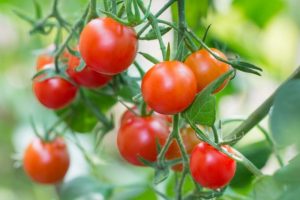
- The tomato does not like humid air, therefore it is necessary to provide ventilation in the greenhouse without creating drafts.
- Watering should be carried out either by drip irrigation or watering the soil directly under the shrub, not pouring the leaves.
- Feed must be carried out only after watering.
- To reduce the humidity of the air and maintain moisture in the soil, it is desirable to mulch it with grass, straw or any air-permeable materials.
- To avoid cracking the fruits, watering after the formation of brushes to make more frequent and less abundant.
- In the greenhouse plants need to be formed more carefully.
- With the onset of cool weather, it is necessary to realistically assess the possibility of ripening of the fruit set and remove the excess.
Like many other hybrids, plants are resistant to many viral and fungal diseases of tomatoes. If you follow the rules of agricultural engineering, vegetable growers usually do without the use of additional treatments with chemicals.
Original fruits of excellent taste delight children and adults throughout the summer, and every year they find more and more fans.
Video: How to grow cherry tomatoes?


